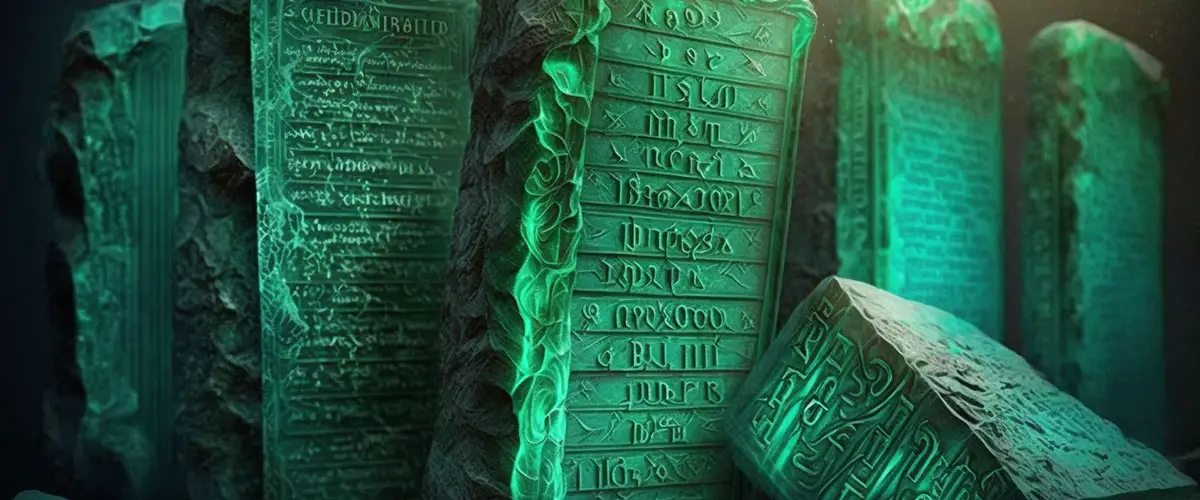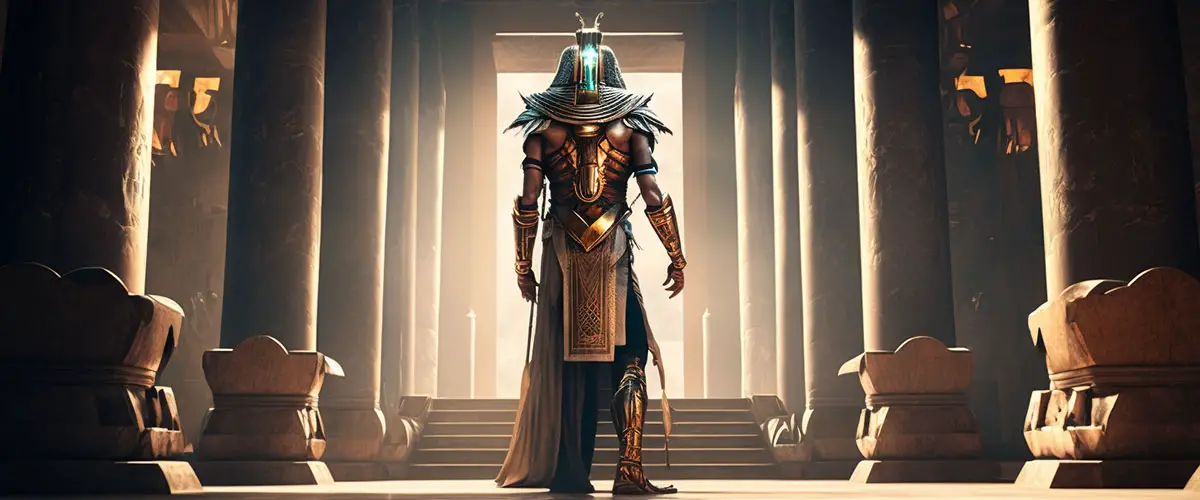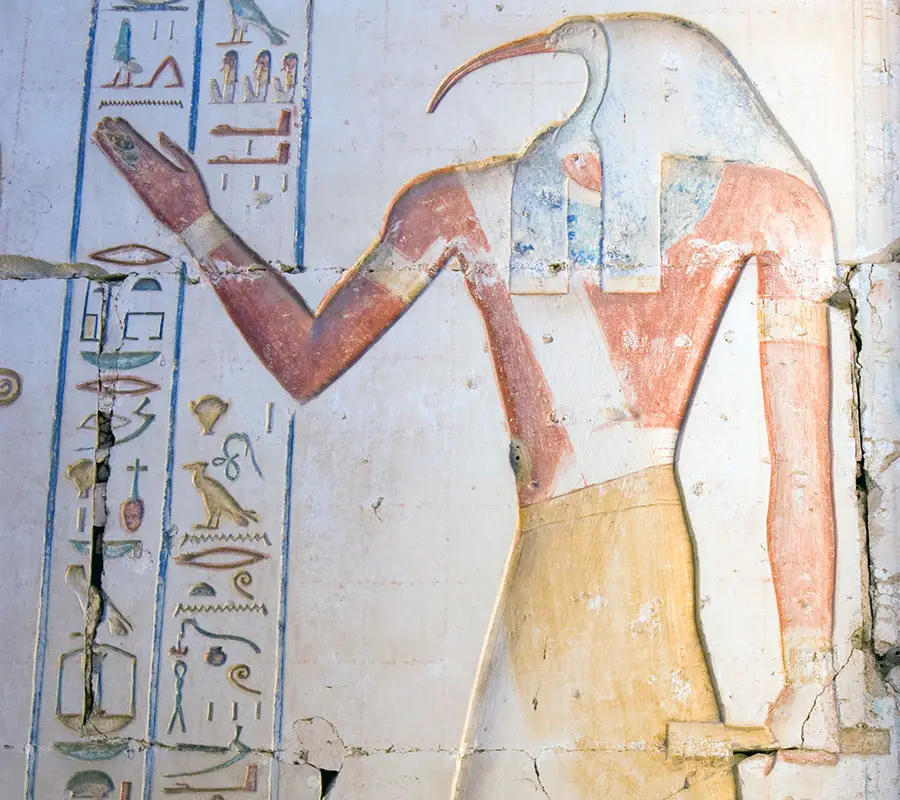Perhaps the most mysterious of all historical texts, the Emerald Tablet supposedly contains knowledge that takes the reader to a level of consciousness beyond normal thought. But much of the mystery surrounding the Emerald Tablet has never been proven. In this article we are going to look at the question: is the Emerald Tablet authentic?
The Emerald Tablet exists only in translated form, and therefore the claims that it dates back 38 000 years cannot be officially proven. The earliest known versions come from the 8th century, having been translated into Arabic and then later Greek and Latin, and the original stone slabs have been lost.

A Recap of What the Emerald Tablet Is
The Emerald Tablet consists of twelve different tablets, which are like chapters. They are made out of a substance created through alchemical transmutation. These tablets are resistant to all forms of wear and tear, and are imperishable. They were supposedly inscribed in the ancient characters of Atlantis. These characters which respond to thought wave lengths and trigger mental vibrations in the mind of the reader. The tablets contain the foundation of the ancient mysteries, or the secrets of the universe. They describe and codify the principles which govern the universe, and are a pillar of western esoteric thought, profoundly influencing medieval and Renaissance science and philosophy.
Exploring the Contents of the Emerald Tablet
The Emerald Tablet, also known as the Smaragdine Tablet or Tabula Smaragdina. Consists of twelve parts. Some of the highlights of these include a description of the seven stages of alchemical transformation: calcination, dissolution, separation, conjunction, fermentation, distillation, coagulation. The phrase “As Above So Below”, which was popularized by 19th century occultists, is paraphrased version of the second verse of the tablet.
Highly regarded by Islamic and European alchemists who considered the text to be the basis of their work. These alchemists sought the Philosopher’s Stone, a substance which they could use to turn base metals such as mercury into gold. They considered this physical transmutation to be an analogy of their spiritual transmutation, in which they would achieve immortality. Their process of seeking the Philosopher’s Stone was known as the Magnum Opus (which means Great Work).
Where Did the Emerald Tablet of Thoth Come From?
Because the origins of the tablets are unclear, and shrouded in legend, much speculation has arisen. Some of these ideas originate from the students of the mystery schools, descendants of the original priests of the temples where Thoth left the tablets. They claim that they have always known the truth as the origins of the tablets, and that they come from Atlantis.
Another popular idea is that the tablet was at one point stored in the Ark of the Covenant. There is a lack of evidence to support these claims, or even the existence of the tablet for that matter. Some claim that the Emerald Tablet was stored and then burned in the Library of Alexandria in ancient Egypt, during the rule of Julius Caesar.
According to Hermetic tradition, The Emerald Tablets date back to 36 000 years BC. Written by Thoth who was Priest-King of Atlantis at the time, also sometimes named Hermes Trismegistus. After Atlantis sank, Thoth led a colony of refugees to Egypt, where they rebuilt their civilization. This included the building of the Great Pyramid of Giza. Thoth ruled this society in Egypt, as well as in central and south America, for 16 000 years. The presence of these Atlanteans, led by Thoth, greatly influenced the local Egyptians, introducing many new ideas and uplifting their consciousness.
Thoth was immortal, meaning he had freed himself of the life and death cycle, and through meditation continued to live indefinitely. Eventually, it became time for Thoth to leave Egypt. That is when he created the Great Pyramid. He built it over the entrance of the Great Halls of Amenti, and placed his records inside, and appointed his most advanced students to guard the secrets. These guards eventually became the high priests of the pyramid. The Halls of Amenti became known as the place where souls would go for judgement after death.

The Emerald Tablet is one of the records Thoth placed in the Halls of Amenti, prior to leaving this dimension.
In late Atleantan and early Egyptian times, the priest exists in fragmented groups. The possession of the Emerald Tablet would give any of these competing factions massive authority and prestige. The group in possession of the tablet moved to South America and founded the Mayan race which flourished and became known for having the world’s most advanced astrology, amongst other things.
The Mayan civilization placed the tablets in one of their temples. Later as a result of war with rival tribes from central Mexico, as well as with the Spaniards from Europe, knowledge of the location of the tablets became lost.
What is the Purpose of the Emerald Tablet?
When Thoth met the Great Dweller in the Halls of Amenti and became immortal, he was instructed to adopt a purpose that would serve to elevate humanity. He chose to be a teacher, and to guide and uplift the evolution of our consciousness. He recorded his wisdom in the tablets so that humanity could continue to learn from him after he left our dimension of reality. Part of his legacy in assisting us is also building the Great Pyramid, which is a temple of initiation into mysteries. To those who are prepared, passage through the Great Pyramid can lead to the achievement of immortality, just as Thoth himself had done. But this is only possible after extensive preparation, and a proper understanding of Thoth’s teachings.
Was Thoth a Real Person?
There are conflicting ideas about the figure known as Thoth during ancient Egypt, Hermes during ancient Greece. He later become known as Hermes Trismegistus during the Hellenistic Period (323 BC – 31 BC). The thinkers of that age recognized the Egyptian god Thoth as being the same deity as the Greek god Hermes. Thoth, the god of writing and knowledge, was combined with Hermes, the messenger of the gods, in a syncretism of the two gods.

In ancient times he was viewed as a god or deity. His presence was recognized in his spirit animals the ibus bird, as well as the baboon. There are many carvings in ancient Egyptian temples depicting him.
As the Egyptians and Greeks became monotheistic, and no longer acknowledged deities the way they had in the past, Hermes Trismegistus started to be seen more as a human author than a deity. He became viewed somewhat like Jesus, a symbolic representation of a warrior monk, leading a mystery cult in Palestine, or a high priest in an Egyptian mystery school. It is Possible he is an amalgamation of multiple authors and historical figures
What is real and unreal is left up to the reader. To the people modern times who claim to have been visited by Thoth, he is living being. And even if you take the position that he was a never a historical figure, the nature of the writings attributed to Hermes Trismegistus are of such a profoundness as to disrupt at least some aspects of what we claim to know about reality.
Recommended Reading
If you want to continue exploring this subject more deeply, you can see which books I recommend by clicking here.
